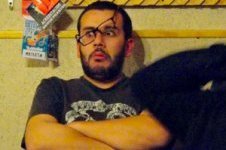Search
To search for an exact match, type the word or phrase you want in quotation marks.
A*DESK has been offering since 2002 contents about criticism and contemporary art. A*DESK has become consolidated thanks to all those who have believed in the project, all those who have followed us, debating, participating and collaborating. Many people have collaborated with A*DESK, and continue to do so. Their efforts, knowledge and belief in the project are what make it grow internationally. At A*DESK we have also generated work for over one hundred professionals in culture, from small collaborations with reviews and classes, to more prolonged and intense collaborations.
At A*DESK we believe in the need for free and universal access to culture and knowledge. We want to carry on being independent, remaining open to more ideas and opinions. If you believe in A*DESK, we need your backing to be able to continue. You can now participate in the project by supporting it. You can choose how much you want to contribute to the project.
You can decide how much you want to bring to the project.

The tenth anniversary of the sinking of the Prestige is the ideal scenario to show the results of work that is long standing. It is not an exhibition about the Prestige, as Pedro del Llano, the curator, untiringly points out. However, it has served for MARCO to celebrate this ten year anniversary, because they opened their doors when the petrol tanker was floundering off the coast of Galicia.
A balea negra (The Black Whale) refers to a premonitory dream in which Manfred Gnädinger, a man who had settled on the Costa da Morte since the seventies, contemplated how a large black whale devastated the coast. Man, the German from Camelle, installed himself in this locality in 1962 and lived there until a few weeks after the accident of the petrol tanker, watching how the open air museum in which had worked for decades was devastated by the black tide; he died swathed in the sadness of the scene which he saw leaning from his window.
Hence the exhibition opens with two pieces that provide the symbolic character of the exhibition proposal. A whale’s skull with an intervention by Man and the only piece that is conserved of the hull of the petrol tanker –a fragment extracted during the Kafkaesque organisation of this crisis that endeavoured to drain the crude from its interior -. The complicated panopticon, that distributes the rooms in the lower part of the MARCO, houses a large sculpture by Damián Ortega that combines the fetish object of the oil barrel with the disequilibrium of this disastrous market. We enter in therefore conscious of the reason behind this exhibition, anxious to contemplate the consequences at the hands of a series of artists who one way or another experienced it first hand.
Roman Signer would say that art is the silence after an explosion. Something immense and terrifying. As is demonstrated by each one of the rooms where the art and urgency generate a sort of amalgam with the improvisation of the town that faced up to the black tide of the Prestige; two large canvases confront each other in which Antón Patiño transformed this impotence in the face of such an uncontainable enemy. Because in Galicia we have sadly become experts on the subject. Polycommander (1970), Erkowit (1973), Urquiola (1976), Andros Patria (1978), Cason (1987), Mar Egeo (1992) and Prestige (2002).
Werner Herzog, Bernardo Bertolucci, Hans Hacke, Peter Hutton or Robert Smithson –all present in the exhibition- have done it. But also Fra Angelico, Van der Weyden, El Bosco or Miguel Angel, because in one way or another, setting aside the spatial-temporal barriers, the theme ends up being the final judgment.
The images that Manuel Sendón or Allan Sekula took during those months of confusion now show certain parallelisms with similar situations experienced across the whole world. Georges Osodi and Romuald Hazoumè do something similar on the African continent, specifically with the Nigerian oil companies. Nobody is safe. The imposing banner unfurled by Mavis Müller and Andrea Bowers in a fishing boat in the bay of Kachemak (Alaska) during the crisis unleashed by the Exxon Valdez disaster, now hangs on one of the walls of the museum. Faithful testimony to the fine line that exists between art and activism.
The ironic Mark Dion has converted one of the rooms into a natural science museum in which the species are shown covered in crude, reproducing these scenes to which we have, by force, become accustomed, but without losing the pathos of that nervous laugh that is drawn on our face even when faced with tragedy. Travelling through there are imposing works that alleviate the documentary weight of the show. The raft of oil by Marcela Armas refers us back to the mirrors that Richard Wilson recreates with his fuel tanks. Rirkrit Tiravanija has for a while now appeared a safe bet, as is corroborated by the immense mural where we read, Less Oil More Courage.
All convulsive times leave behind indelible gestures from which spring a light of hope. As Robert Rauschenberg showed with his gluts, in the macabre beauty of a tin landscape that had rendered itself at the feet of a progress, that marched onward to the tic-tac of a bomb.
Less Oil More Courage.

Ángel Calvo Ulloa was born in a very small place full of vile characters. In the faculty where he studied nobody ever talked to him about criticism or curating, so now he dedicates his time to reading, writing and every now and again doing the odd exhibition. He loves travelling and feeling very small in a large city. He also loves going back home and once again hating this tiny place.
"A desk is a dangerous place from which to watch the world" (John Le Carré)